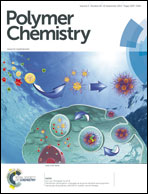Microwave-assisted solution polycondensation of l-lactic acid using a Dean–Stark apparatus for a non-thermal microwave polymerization effect induced by the electric field†
Abstract
We examined the solution polycondensation of L-lactic acid (L-LA) in xylene catalyzed by scandium trifluoromethanesulfonate using a Dean–Stark apparatus under various microwave power conditions (100–400 W). At the optimum irradiation power (300 W) and 3 M L-LA, we obtained poly(L-lactic acid) (PLLA) with a weight-average molecular weight (Mw) of 11.6 × 103. Using 1.0 mol% SnCl2 as the catalyst and multi-mode irradiation, the largest PLLA (Mw = 46.7 × 103) was obtained, which is a Mw greater than that obtained by conventional heating at the same temperature. We also performed microwave-assisted polycondensation of L-LA using a single-mode microwave cavity that separated microwave electric and magnetic fields. The PLLA Mw values decreased as the irradiation power of the magnetic field increased. Conversely, PLLA with a Mw > 10 000 was obtained by increasing the electric field power despite using the same conditions. The results indicate the existence of a non-thermal microwave effect induced by an electric field.


 Please wait while we load your content...
Please wait while we load your content...